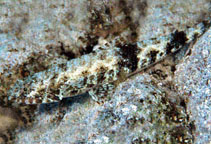| Family: |
Synodontidae (Lizardfishes), subfamily: Harpadontinae |
| Max. size: |
32 cm SL (male/unsexed) |
| Environment: |
reef-associated; marine; depth range 0 - 135 m |
| Distribution: |
Indo-Pacific: Red Sea and East Africa to the Hawaiian, Marquesan and Ducie islands, north to the Ryukyu and Ogasawara islands, south to the Great Barrier Reef, Lord Howe, and Rapa. |
| Diagnosis: |
Dorsal spines (total): 0-0; Dorsal soft rays (total): 11-12; Anal spines: 0-0; Anal soft rays: 9-10. Posterior part of body with blackish blotches; dorsal, caudal and pelvic fins with dark traverse bands (Ref. 11228).
Description: Characterized by visible teeth when mouth is closed; dorsal fin origin between midpoint between snout and adipose fin; vertical from tip of pectoral fin equal with level of second or third predorsal scale; pectoral fins reaching posterior to level of pelvic fin origin (Ref. 90102). |
| Biology: |
Inhabits sand and silty reefs (Ref. 58652). Benthic (Ref. 58302). Common in shallow lagoons, reef flats, and sheltered seaward reefs. Feeds on fishes and ocacionally on crustaceans (Ref. 89972). Active at night (Ref. 5213). Caught with artisanal gear. Solitary (Ref 90102). |
| IUCN Red List Status: |
Least Concern (LC); Date assessed: 02 March 2015 Ref. (130435)
|
| Threat to humans: |
harmless |
Source and more info: www.fishbase.org. For personal, classroom, and other internal use only. Not for publication.
